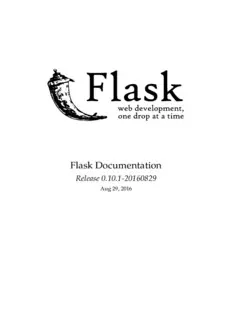
Flask Documentation - Flask (A Python Microframework) PDF
Preview Flask Documentation - Flask (A Python Microframework)
Flask Documentation Release 0.10.1-20170321 Mar 21, 2017 CONTENTS I User’s Guide 1 1 Foreword 3 2 ForewordforExperiencedProgrammers 5 3 Installation 7 4 Quickstart 11 5 Tutorial 27 6 Templates 39 7 TestingFlaskApplications 43 8 LoggingApplicationErrors 51 9 DebuggingApplicationErrors 57 10 ConfigurationHandling 59 11 Signals 67 12 PluggableViews 75 13 TheApplicationContext 81 14 TheRequestContext 85 15 ModularApplicationswithBlueprints 91 16 FlaskExtensions 97 17 WorkingwiththeShell 99 18 PatternsforFlask 101 19 DeploymentOptions 157 i 20 BecomingBig 171 II API Reference 175 21 API 177 III Additional Notes 235 22 DesignDecisionsinFlask 237 23 HTML/XHTMLFAQ 241 24 SecurityConsiderations 247 25 UnicodeinFlask 251 26 FlaskExtensionDevelopment 255 27 PocooStyleguide 263 28 Python3Support 267 29 UpgradingtoNewerReleases 269 30 FlaskChangelog 277 31 License 289 Index 293 ii Part I USER’S GUIDE This part of the documentation, which is mostly prose, begins with some background information about Flask, then focuses on step-by-step instructions for web develop- mentwithFlask. 1 2 CHAPTER ONE FOREWORD Read this before you get started with Flask. This hopefully answers some questions about the purpose and goals of the project, and when you should or should not be usingit. 1.1 What does “micro” mean? “Micro”doesnotmeanthatyourwholewebapplicationhastofitintoasinglePython file, although it certainly can. Nor does it mean that Flask is lacking in functionality. The “micro” in microframework means Flask aims to keep the core simple but exten- sible. Flask won’t make many decisions for you, such as what database to use. Those decisionsthatitdoesmake,suchaswhattemplatingenginetouse,areeasytochange. Everything else is up to you, so that Flask can be everything you need and nothing youdon’t. Bydefault,Flaskdoesnotincludeadatabaseabstractionlayer,formvalidationorany- thing else where different libraries already exist that can handle that. Instead, Flask supports extensions to add such functionality to your application as if it was imple- mented in Flask itself. Numerous extensions provide database integration, form val- idation, upload handling, various open authentication technologies, and more. Flask maybe“micro”,butit’sreadyforproductionuseonavarietyofneeds. 1.2 Configuration and Conventions Flask has many configuration values, with sensible defaults, and a few conventions when getting started. By convention templates and static files are stored in subdirec- tories within the application’s Python source tree, with the names templates and static respectively. While this can be changed you usually don’t have to, especially when gettingstarted. 3 1.3 Growing with Flask Once you have Flask up and running, you’ll find a variety of extensions available in the community to integrate your project for production. The Flask core team reviews extensionsandensuresapprovedextensionsdonotbreakwithfuturereleases. As your codebase grows, you are free to make the design decisions appropriate for your project. Flask will continue to provide a very simple glue layer to the best that Python has to offer. You can implement advanced patterns in SQLAlchemy or an- otherdatabasetool,introducenon-relationaldatapersistenceasappropriate,andtake advantageofframework-agnostictoolsbuiltforWSGI,thePythonwebinterface. Flask includes many hooks to customize its behavior. Should you need more cus- tomization, the Flask class is built for subclassing. If you are interested in that, check outtheBecomingBigchapter. IfyouarecuriousabouttheFlaskdesignprinciples,head overtothesectionaboutDesignDecisionsinFlask. ContinuetoInstallation,theQuickstart,ortheForewordforExperiencedProgrammers. 4 CHAPTER TWO FOREWORD FOR EXPERIENCED PROGRAMMERS 2.1 Thread-Locals in Flask One of the design decisions in Flask was that simple tasks should be simple; they should not take a lot of code and yet they should not limit you. Because of that, Flask hasfewdesignchoicesthatsomepeoplemightfindsurprisingorunorthodox. Forex- ample,Flaskusesthread-localobjectsinternallysothatyoudon’thavetopassobjects around from function to function within a request in order to stay threadsafe. This approach is convenient, but requires a valid request context for dependency injection orwhenattemptingtoreusecodewhichusesavaluepeggedtotherequest. TheFlask projectishonestaboutthread-locals,doesnothidethem,andcallsoutinthecodeand documentationwheretheyareused. 2.2 Develop for the Web with Caution Alwayskeepsecurityinmindwhenbuildingwebapplications. If you write a web application, you are probably allowing users to register and leave theirdataonyourserver. Theusersareentrustingyouwithdata. Andevenifyouare the only user that might leave data in your application, you still want that data to be storedsecurely. Unfortunately, there are many ways the security of a web application can be com- promised. Flask protects you against one of the most common security problems of modern web applications: cross-site scripting (XSS). Unless you deliberately mark in- secure HTML as secure, Flask and the underlying Jinja2 template engine have you covered. Buttherearemanymorewaystocausesecurityproblems. The documentation will warn you about aspects of web development that require at- tention to security. Some of these security concerns are far more complex than one might think, and we all sometimes underestimate the likelihood that a vulnerability willbeexploited-untilacleverattackerfiguresoutawaytoexploitourapplications. And don’t think that your application is not important enough to attract an attacker. 5 Dependingonthekindofattack,chancesarethatautomatedbotsareprobingforways tofillyourdatabasewithspam,linkstomalicioussoftware,andthelike. Flask is no different from any other framework in that you the developer must build withcaution,watchingforexploitswhenbuildingtoyourrequirements. 2.3 The Status of Python 3 Currently the Python community is in the process of improving libraries to support thenewiterationofthePython programminglanguage. Whilethesituationisgreatly improving there are still some issues that make it hard for users to switch over to Python 3 just now. These problems are partially caused by changes in the language that went unreviewed for too long, partially also because we have not quite worked out how the lower- level API should change to account for the Unicode differences in Python3. We strongly recommend using Python 2.6 and 2.7 with activated Python 3 warnings during development. If you plan on upgrading to Python 3 in the near future we stronglyrecommendthatyoureadHowtowriteforwardscompatiblePythoncode. IfyoudowanttodiveintoPython3alreadyhavealookatthepython3_supportpage. ContinuetoInstallationortheQuickstart. 6
